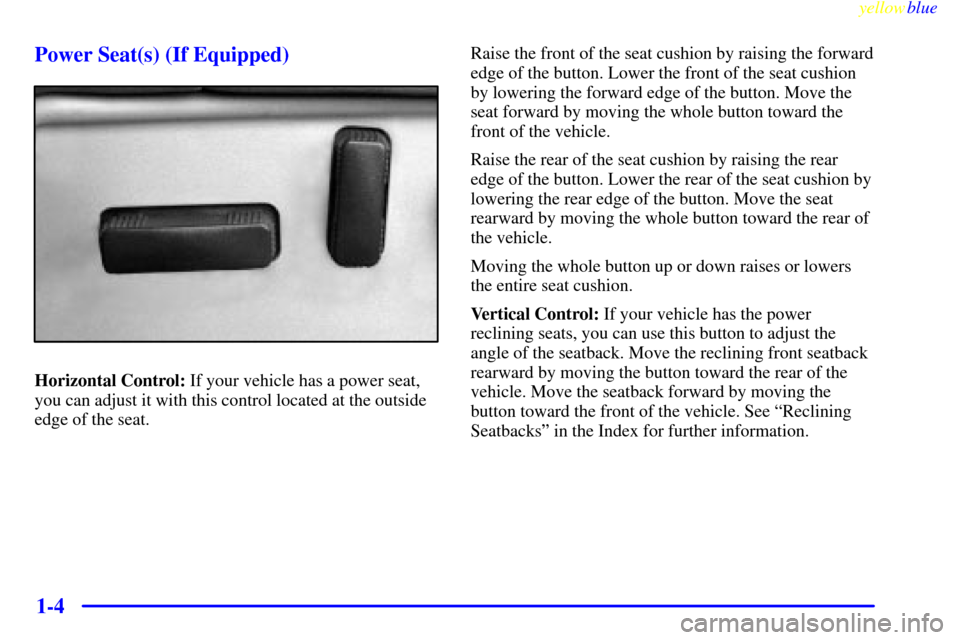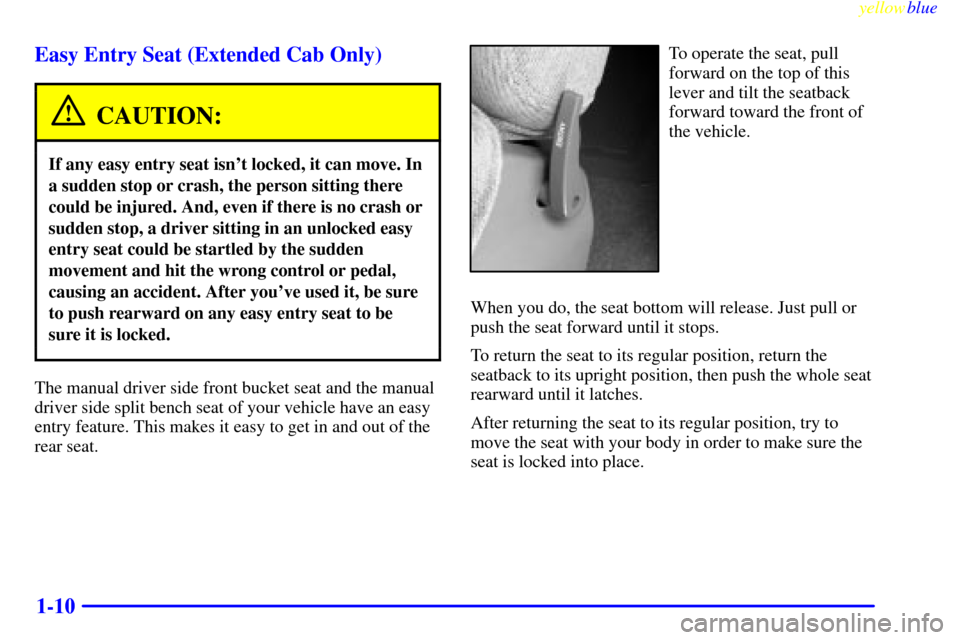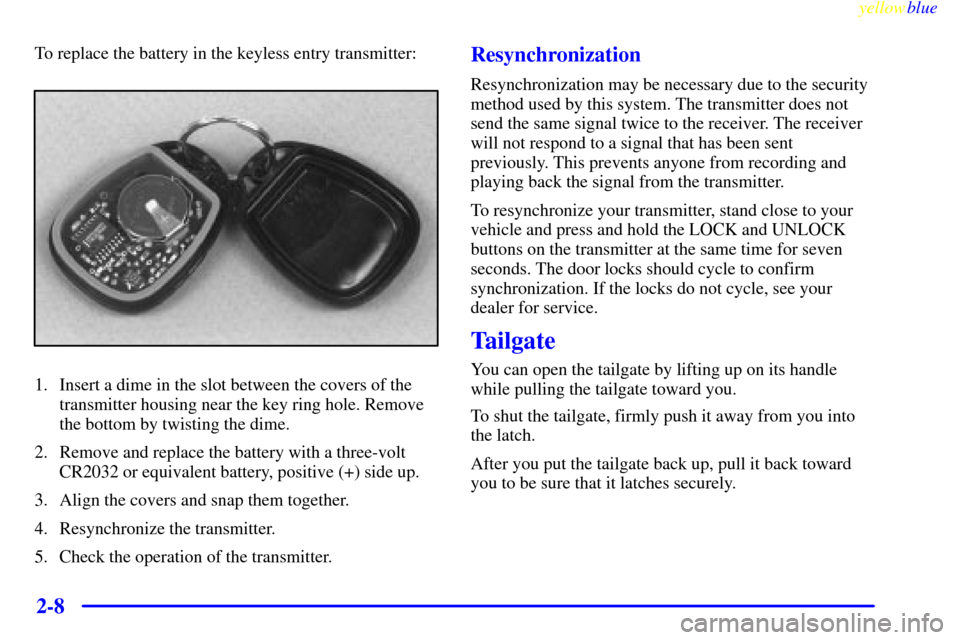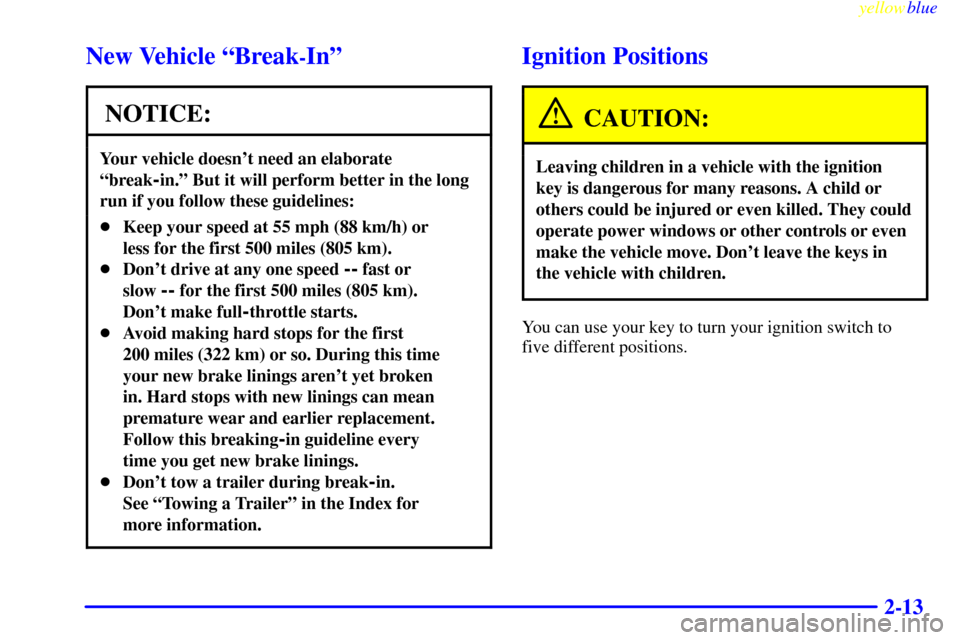Page 9 of 432
yellowblue
1-3
Cushion Tilt (If Equipped)
If your vehicle has this feature, you can raise or lower
the front of the driver's or passenger's seat with this
lever located at the inside edge of the seat. To raise or
lower the front of the seat, move the lever up or down in
a continuous motion until the cushion reaches the
desired height.
Manual Lumbar Control (If Equipped)
If your vehicle has a lumbar
adjustment, you can
increase or decrease lumbar
support in an area of the
lower seatback.
To increase support, turn the knob towards the front of
the vehicle.
To decrease support, turn the knob towards the rear of
the vehicle.
Page 10 of 432

yellowblue
1-4 Power Seat(s) (If Equipped)
Horizontal Control: If your vehicle has a power seat,
you can adjust it with this control located at the outside
edge of the seat.Raise the front of the seat cushion by raising the forward
edge of the button. Lower the front of the seat cushion
by lowering the forward edge of the button. Move the
seat forward by moving the whole button toward the
front of the vehicle.
Raise the rear of the seat cushion by raising the rear
edge of the button. Lower the rear of the seat cushion by
lowering the rear edge of the button. Move the seat
rearward by moving the whole button toward the rear of
the vehicle.
Moving the whole button up or down raises or lowers
the entire seat cushion.
Vertical Control: If your vehicle has the power
reclining seats, you can use this button to adjust the
angle of the seatback. Move the reclining front seatback
rearward by moving the button toward the rear of the
vehicle. Move the seatback forward by moving the
button toward the front of the vehicle. See ªReclining
Seatbacksº in the Index for further information.
Page 16 of 432

yellowblue
1-10 Easy Entry Seat (Extended Cab Only)
CAUTION:
If any easy entry seat isn't locked, it can move. In
a sudden stop or crash, the person sitting there
could be injured. And, even if there is no crash or
sudden stop, a driver sitting in an unlocked easy
entry seat could be startled by the sudden
movement and hit the wrong control or pedal,
causing an accident. After you've used it, be sure
to push rearward on any easy entry seat to be
sure it is locked.
The manual driver side front bucket seat and the manual
driver side split bench seat of your vehicle have an easy
entry feature. This makes it easy to get in and out of the
rear seat.
To operate the seat, pull
forward on the top of this
lever and tilt the seatback
forward toward the front of
the vehicle.
When you do, the seat bottom will release. Just pull or
push the seat forward until it stops.
To return the seat to its regular position, return the
seatback to its upright position, then push the whole seat
rearward until it latches.
After returning the seat to its regular position, try to
move the seat with your body in order to make sure the
seat is locked into place.
Page 35 of 432

yellowblue
1-29
In any particular crash, no one can say whether an air
bag should have inflated simply because of the damage
to a vehicle or because of what the repair costs were.
Inflation is determined by the angle of the impact and
how quickly the vehicle slows down in frontal or
near
-frontal impacts.
The air bag system is designed to work properly under a
wide range of conditions, including off
-road usage.
Observe safe driving speeds, especially on rough terrain.
As always, wear your safety belt. See ªOff
-Road
Drivingº in the Index for more tips on off
-road driving.
What makes an air bag inflate?
In an impact of sufficient severity, the air bag sensing
system detects that the vehicle is in a crash. The sensing
system triggers a release of gas from the inflator, which
inflates the air bag. The inflator, air bag and related
hardware are all part of the air bag modules inside the
steering wheel and in the instrument panel in front of the
right front passenger.How does an air bag restrain?
In moderate to severe frontal or near
-frontal collisions,
even belted occupants can contact the steering wheel or the
instrument panel. Air bags supplement the protection
provided by safety belts. Air bags distribute the force of
the impact more evenly over the occupant's upper body,
stopping the occupant more gradually. But air bags would
not help you in many types of collisions, including
rollovers, rear impacts and side impacts, primarily because
an occupant's motion is not toward those air bags. Air
bags should never be regarded as anything more than a
supplement to safety belts, and then only in moderate to
severe frontal or near
-frontal collisions.
What will you see after an air bag inflates?
After an air bag inflates, it quickly deflates, so quickly
that some people may not even realize the air bag
inflated. Some components of the air bag module
-- the
steering wheel hub for the driver's air bag, or the
instrument panel for the right front passenger's
bag
-- will be hot for a short time. The parts of the
bag that come into contact with you may be warm, but
not too hot to touch. There will be some smoke and
dust coming from vents in the deflated air bags. Air bag
inflation doesn't prevent the driver from seeing or from
being able to steer the vehicle, nor does it stop people
from leaving the vehicle.
Page 52 of 432
yellowblue
1-46
Child Restraints
Every time infants and young children ride in
vehicles, they should have protection provided by
appropriate restraints.
Q:What are the different types of add-on
child restraints?
A:Add-on child restraints are available in four basic
types. When selecting a child restraint, take into
consideration not only the child's weight and size,
but also whether or not the restraint will be
compatible with the motor vehicle in which it will
be used.
An infant car bed (A) is a special bed made for use
in a motor vehicle. It's an infant restraint system
designed to restrain or position a child on a
continuous flat surface. With an infant car bed,
make sure that the infant's head rests toward the
center of the vehicle.
Page 70 of 432
yellowblue
1-64
CAUTION:
Never do this.
Here two children are wearing the same belt. The
belt can't properly spread the impact forces. In a
crash, the two children can be crushed together
and seriously injured. A belt must be used by
only one person at a time.
Q:What if a child is wearing a lap-shoulder belt,
but the child is so small that the shoulder belt is
very close to the child's face or neck?
A:Move the child toward the center of the vehicle, but
be sure that the shoulder belt still is on the child's
shoulder, so that in a crash the child's upper body
would have the restraint that belts provide. If the
child is sitting in a rear seat outside position, see
ªRear Safety Belt Comfort Guidesº in the Index.
If the child is so small that the shoulder belt is still
very close to the child's face or neck, you might
want to place the child in a seat that has a lap belt,
if your vehicle has one.
Page 80 of 432

yellowblue
2-8
To replace the battery in the keyless entry transmitter:
1. Insert a dime in the slot between the covers of the
transmitter housing near the key ring hole. Remove
the bottom by twisting the dime.
2. Remove and replace the battery with a three-volt
CR2032 or equivalent battery, positive (+) side up.
3. Align the covers and snap them together.
4. Resynchronize the transmitter.
5. Check the operation of the transmitter.
Resynchronization
Resynchronization may be necessary due to the security
method used by this system. The transmitter does not
send the same signal twice to the receiver. The receiver
will not respond to a signal that has been sent
previously. This prevents anyone from recording and
playing back the signal from the transmitter.
To resynchronize your transmitter, stand close to your
vehicle and press and hold the LOCK and UNLOCK
buttons on the transmitter at the same time for seven
seconds. The door locks should cycle to confirm
synchronization. If the locks do not cycle, see your
dealer for service.
Tailgate
You can open the tailgate by lifting up on its handle
while pulling the tailgate toward you.
To shut the tailgate, firmly push it away from you into
the latch.
After you put the tailgate back up, pull it back toward
you to be sure that it latches securely.
Page 85 of 432

yellowblue
2-13
New Vehicle ªBreak-Inº
NOTICE:
Your vehicle doesn't need an elaborate
ªbreak
-in.º But it will perform better in the long
run if you follow these guidelines:
�Keep your speed at 55 mph (88 km/h) or
less for the first 500 miles (805 km).
�Don't drive at any one speed
-- fast or
slow
-- for the first 500 miles (805 km).
Don't make full
-throttle starts.
�Avoid making hard stops for the first
200 miles (322 km) or so. During this time
your new brake linings aren't yet broken
in. Hard stops with new linings can mean
premature wear and earlier replacement.
Follow this breaking
-in guideline every
time you get new brake linings.
�Don't tow a trailer during break
-in.
See ªTowing a Trailerº in the Index for
more information.
Ignition Positions
CAUTION:
Leaving children in a vehicle with the ignition
key is dangerous for many reasons. A child or
others could be injured or even killed. They could
operate power windows or other controls or even
make the vehicle move. Don't leave the keys in
the vehicle with children.
You can use your key to turn your ignition switch to
five different positions.